Derby Lightweight DMU images
« ‹ Page 16 of 25, displaying 301-320 of 498 images › »
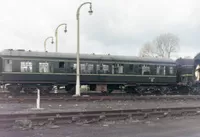
circa early 1970
Derby Lightweight DTCL M79656 stored at Ipswich loco shed circa early 1970. For almost all its life it was an LMR vehicle, it would be transferred from Bletchley to Norwich - probably with 79133 in summer 1967 - it was withdrawn from that depot in October 1967 and would eventually be disposed of to the Bird Group at Long Marston in February 1973. It faces a Met-Camm "Lightweight". Tony Wilkins.
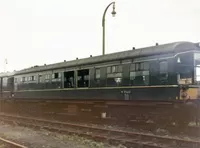
circa early 1970
With two window frames removed Derby Lightweight DTCL M79665 is seen stored at Ipswich loco shed circa early 1970. The vehicle was likely transferred from Bletchley to Norwich in summer 1967, it was withdrawn from that depot in October 1967 and would eventually be disposed of to the Bird Group at Long Marston in February 1973. Tony Wilkins.

early 1970
A withdrawn Eastern Region Derby Lightweight vehicle in the George Cohen Ltd scrapyard at Cransley (Kettering) in early 1970. Note the missing buffer. Tony Wilkins.
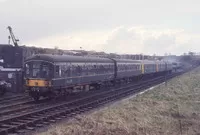
May 1970
DMUs in Cohen's Cransley (Kettering) scrapyard in May 1970. Left to right are a Derby Lightweight DTCL, thought to be E79260, a Met-Camm Lightweight DTSL (thought to be 79278), DMBS, DMBS and DTSL. The their right is a MCL DTSL (blue with yellow panel) and Derby Lightweight DTSL. Above them in sidings behind are at least another four DMU vehicles. Stuart Mackay Collection.

21st June 1970
BR blue 'Derby Lightweight' driving trailer M79184 awaiting the torch at George Cohen's scrapyard at Cransley near Kettering on 21st June 1970. A victim of the many branch lines axed in the 1960's and being non-standard 'Yellow Diamond' coupling code. Gordon Edgar.

21st June 1970
Still in its original green livery, 'Derby Lightweight motor coach' E79025 awaiting its fate at George Cohen's scrapyard at Cransley, near Kettering on 21st June 1970. A victim of wholesale line closures in the 1960s. Gordon Edgar.
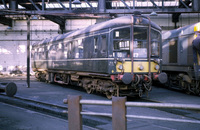
9th August 1970
975010 in York roundhouse, 9/8/70. David Mant.
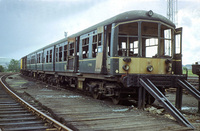
15th August 1970
Derby Lightweight vehicles E79150 and E79402 at South Gosforth on 15 August 1970. Both vehicles were from the four-car NER sets and would be cut up at the depot in July 1971. At the rear of the siding is a blue Cravens vehicle. David Mant.
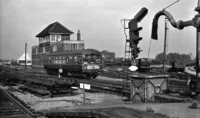
10th October 1970
Derby Lightweight Eastern Region route learner DB975010 (ex-79900) approaches Northallerton on 10 October 1970. Paul Braybrook.
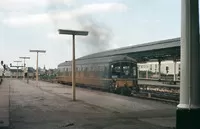
circa 1971
Route learner DB975010 departs from York station, thought to be circa 1971. Stuart Mackay Collection.

1971
The remains (underframe and number panel) of Derby Lightweight 79633 at Cohen's Kettering yard, probably in 1971. It had been built as power car 79191 before conversion to a trailer in 1962. Behind, another vehicle awaits the chop. The grey material scattered all over the ground is blue asbestos. Tony Wilkins.

Unknown Date
A Derby Lightweight DMBS inside Norwich erecting shop circa 1971. The caption states it's a 'scrap car' so it's perhaps undergoing component recovery. Tim Stubbs.
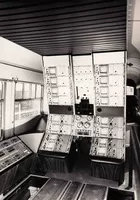
circa March 1971
The equipment operation control position on DB975008, part of the ultrasonic test train, circa March 1971. The operator can monitor the signals being recorded on film and the operation of the camera, and adjust the positions of the ultrasonic probes which he can observe through transparent panels in the floor. Image courtesy of Philip C Johnson. British Railways Board.
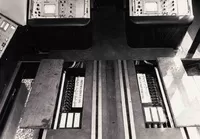
circa March 1971
The floor at the control desk area on Derby Lightweight Ultrasonic Test Train vehicle 975008. It shows two flaps opened up to show access to equipment and the floor windows which allow observation of the probe trolley. Image courtesy of Philip C Johnson. British Railways Board.

circa March 1971
The 35mm photographic recording unit inside 975008, part of the Derby Lightweight Ultrasonic Test Train. These recorded the results from the probes, the analysis of the film afterwards was a slow manual process restricting operation to about 2,000 miles a year. They were later replaced with magnetic tape, the digital analysis was much faster allowing yearly mileage to be increased to about 10,000 miles a year. Image courtesy of Philip C Johnson. British Railways Board.
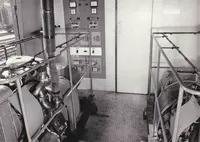
circa March 1971
The two generators in the former brake van of 975007, the power car on the Derby Lightweight Ultrasonic Test Train. The inner rail around the top is part of the fire suppression system similar to that fitted above DMU engines. Image courtesy of Philip C Johnson. British Railways Board.

circa March 1971
An official image showing British Railways new two-vehicle ultrasonic rail testing train at work. The power car DB975007 is leading, the trolley carrying the ultrasonic probes is mounted underneath the trailer car (DB975008). Taken circa March 1971, the vehicles were formerly M79018 and M79612 based in the West Cumberland area. British Railways Board.

circa March 1971
An official image showing the trolley under ultrasonic test car DB975008 (ex-79612). This carried the ultrasonic probe heads, these could be lifted to pass over points and crossings, the whole trolley would be raised clear of the rails to allow running at normal traffic speeds. British Railways Board.

circa March 1971
An official image showing the cab of one of the vehicles (975007 or 975008) of the ultrasonic test train circa March 1971. The extra raised seat in the centre of the cab was for the logger who would use the keyboard on the console to note the sighting of lineside mileposts which would record then on the film produced by the ultrasonic test gear. A third seat, out of view, was fro the train captain. Note the traditional Yellow Diamond 'cowhorn' throttle and the matching early style gear controlled has been replaced by the later style controls used on Blue Square vehicles. British Railways Board.

circa March 1971
An official image showing the cab of one of the vehicles (975007 or 975008) of the ultrasonic test train circa March 1971. The crew are sitting in position, probably just posing for the photograph, the driver to the left and the logger on the right. Out of sight to the right is another seat position for the train captain. British Railways Board.
Derby Lightweight DMU Images


